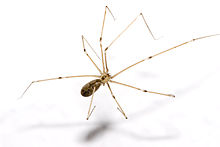Great trembling spider
| Great trembling spider | ||||||||||||
|---|---|---|---|---|---|---|---|---|---|---|---|---|

Great trembling spider ( Pholcus phalangioides ) |
||||||||||||
| Systematics | ||||||||||||
|
||||||||||||
| Scientific name | ||||||||||||
| Pholcus phalangioides | ||||||||||||
| ( Fuesslin , 1775) |
The great quiver spider ( Pholcus phalangioides ) is a species of weaving spider from the family of the quiver spider (Pholcidae). The name "trembling spider" is derived from the defensive behavior of these spiders. If you feel threatened, start to set yourself and your network in motion. As a result, their bodies become blurred against the background and they become almost invisible (this works less well in front of the light, unpatterned walls in houses). The development of this behavior decreases with increasing age of the animals and through contact with humans.
The great trembling spider comes from the subtropics and has spread from there almost worldwide. It is only absent in cool and cold climates. As a distinct type of cave, it can now be found in almost every building, especially in cellars.
The Great Shivering Spider was voted Spider of the Year 2003 by the Arachnological Society .
Appearance
The great trembling spider is often found in buildings or basements and quiet corridors, where it lies in wait for prey with its belly up in its web. Their gray-brown patterned body is rod-shaped, males are around six millimeters long, females rarely up to ten millimeters. Because of its up to five centimeters long legs, it is, like other trembling spiders, often confused with the harvestmen (Opiliones). A close relative of the large quiver spider, the small quiver spider , therefore tellingly bears the name Pholcus opilionoides (similar to a weaver). In contrast to the oval, undivided body of the harvestmen, the body of the trembling spider, as with all weaving spiders , is clearly divided into the front body ( prosoma ) and the abdomen ( opisthosoma ). In the male, the buttons are thickened club-shaped by the sexual organs, while the females have thin buttons.
nutrition


The large trembling spider feeds mainly on smaller animals such as flies , mosquitoes or wood lice , only when there is a persistent lack of food also on other species. But thanks to its special fishing technique, it can even overwhelm the larger angle spiders ("house spiders"). The web of the ecribellate spider is an irregular and loose fabric and has non-sticky threads that are extremely elastic and permanently effective. If the spider has noticed prey due to the vibrations in the web, it runs towards it and weaves it in with additional shackles.
Reproduction
The females can live up to three years old; males usually die earlier. Large quiver spiders are ready to mate all year round. The female lays an average of about 20 eggs, which are spun into a thin cocoon and carried around by the mother until the young hatch. Accordingly, brood care is carried out to a certain extent . After hatching, the young remain in the cocoon for a short time before they leave their mother and are on their own.
Distribution area
The great trembling spider is found in all temperate climates on earth. It does not occur in the desert or beyond the Arctic Circle, nor in the tropical regions of Africa. However, it is represented in the rainforest of South America.
literature
- Gabriele Uhl, reproductive biology of trembling spiders (Pholcus phalangioides; Pholcidae; Araneae) , Diss. Univ. Freiburg, 1994
- Heiko Bellmann: Spiders. Observe - determine. 2nd Edition. Naturbuch, Augsburg 1992, ISBN 3-89440-064-1 .
- Dick Jones: The Cosmos Spider Guide. Franckh, Stuttgart 1990, ISBN 3-440-06141-8 .
- Rainer F. Foelix: Biology of the spiders. 2nd Edition. Thieme, Stuttgart 1992, ISBN 3-13-575802-8 .
- Martin Kreuels: The trembling spider Pholcus phalangioides. (PDF; 1.6 MB) In: Pest Control. 39, No. 21, 2008.
Web links
Pholcus phalangioides in the World Spider Catalog
- Large trembling spider on natur-in-nrw.de
- Pholcus phalangioides in the spider forum Wiki
- The life cycle of the large trembling spider , observations by Jörg Pageler, in the spider forum Wiki





